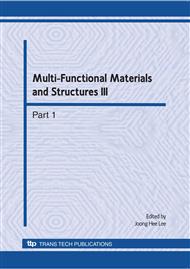p.217
p.221
p.226
p.231
p.235
p.239
p.243
p.247
p.251
Study on Impact Fractures of Adhesively Bonded Composite Joints
Abstract:
From the impact experiment for the nonlinear plastic behavior with the dynamically loaded adhesively-bonded TDCB specimens, there is the range of load from 1 to 2 kN or pin displacement from 4 to 10 mm for the most part in case of the impact rates 1, 2.5, 5, 7.5 and 12.5m/s. There is also the range of energy from 5 to 10 J or energy release rate(fracture energy) from 3000 to 6000 J/m2 for the most part in case of all impact rates. The fracture energy on automotive adhesive joints can be estimated by using the fracture toughness, GIC, experimental results under high rates of loading in this study. The key fracture mechanics parameter, namely the fracture energy, GIC, was ascertained as a function of test rate and may be used to assess and model the joint performance.
Info:
Periodical:
Pages:
235-238
Citation:
Online since:
August 2010
Price:
Сopyright:
© 2010 Trans Tech Publications Ltd. All Rights Reserved
Share:
Citation:


